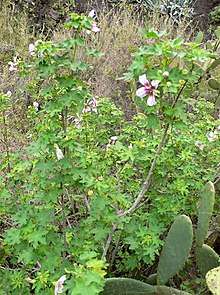Malva acerifolia
| Malva acerifolia | |
|---|---|
 | |
| Scientific classification | |
| Kingdom: | Plantae |
| Clade: | Angiosperms |
| Clade: | Eudicots |
| Clade: | Rosids |
| Order: | Malvales |
| Family: | Malvaceae |
| Genus: | Malva |
| Species: | M. acerifolia |
| Binomial name | |
| Malva acerifolia | |
| Synonyms | |
| |
Malva acerifolia, synonyms Lavatera acerifolia, Malva canariensis, malva de risco in Spanish, is a shrub endemic to the Canary Islands, belonging to the family Malvaceae. It grows in the basal parts of the islands, in a dry, sunny, environment. It loves nitrogen rich soils, especially those somewhat ruderalized.
It is pollinated by insects, especially by bees.
This endemic plant has a Mediterranean origin and it is more recent than the other endemics to the Canary Islands, such as Navaea phoenicea, which colonized the islands earlier and independently from Lavatera acerifolia. Its closest relative is not known as there are some incongruences between chloroplasm and nuclear molecular markers.
The species is abundant and there are no threats against natural populations.
.jpg) Flower
Flower
Taxonomy
The species was first described by Antonio José Cavanilles in 1803 as Lavatera acerifolia.[4] It was transferred to Malva by Friedrich Alefeld in 1862,[5][6] although this was not accepted by most other botanists until much later.[7] In 1842, the name "Malva acerifolia" had been mentioned by Wilhelm Gerhard Walpers in relation to a quite different North American species that Walpers called Sphaeralcea acerifolia (now Iliamna rivularis). On this basis, in 1998, Martin Forbes Ray published the replacement name Malva canariensis.[7] Although this is regarded as the correct name by some sources,[2] the International Plant Names Index treats Walpers' Malva acerifolia as erroneous so that the replacement name is unnecessary and hence superfluous and illegitimate.[3]
References
- ↑ "Malva acerifolia (Cav.) Alef.", Plants of the World Online, Royal Botanic Gardens, Kew, retrieved 2018-01-30
- 1 2 "Malva canariensis", The Plant List, retrieved 2018-01-30
- 1 2 "Plant Name Details for Malva canariensis M.F.Ray", The International Plant Names Index, retrieved 2018-01-31
- ↑ Cavanilles, Antonio Josef (1803), "Observaciones bótanicas y descripcion de algunas plantas neuvas", Anales de Ciencias Naturales (in Spanish and Latin), 6 (16): 323–340, retrieved 2018-01-30 , p. 339
- ↑ "Plant Name Details for Malva acerifolia (Cav.) Alef.", The International Plant Names Index, retrieved 2018-01-31
- ↑ Alefeld, F.G.C. (1862), "Uber die Malveen", Österreichische botanische Zeitschrift (in German), 12: 246–261, retrieved 2018-01-30 , p. 258
- 1 2 Ray, Martin Forbes (1998), "New combinations in Malva (Malvaceae: Malveae)", Novon, 8 (3): 288–295, retrieved 2018-01-30